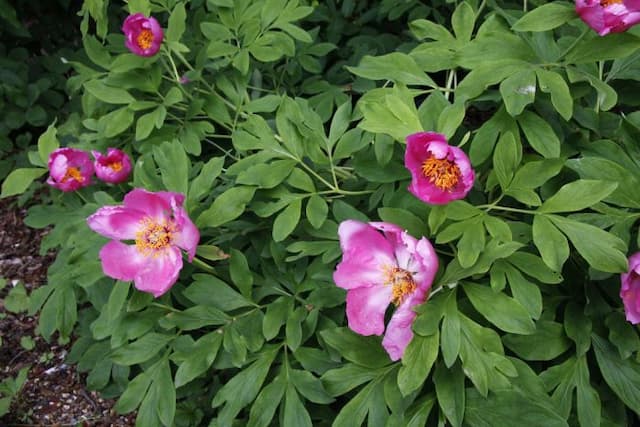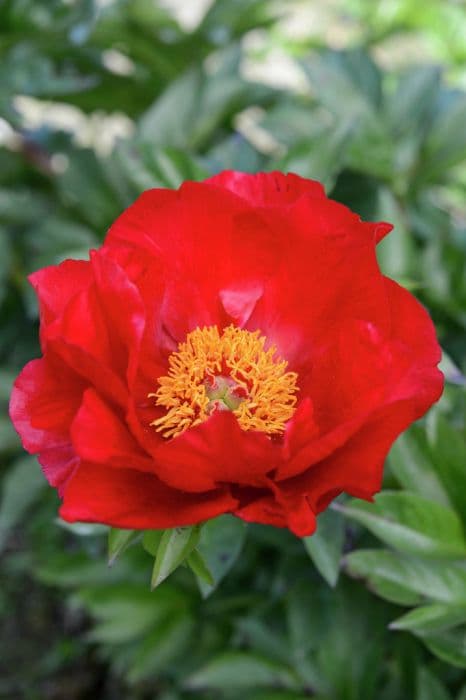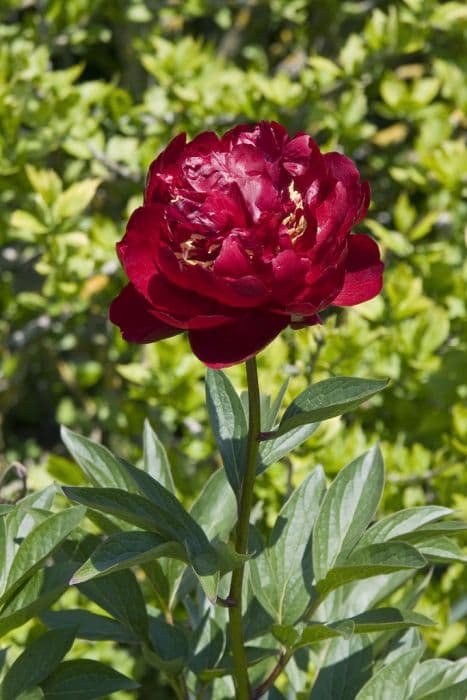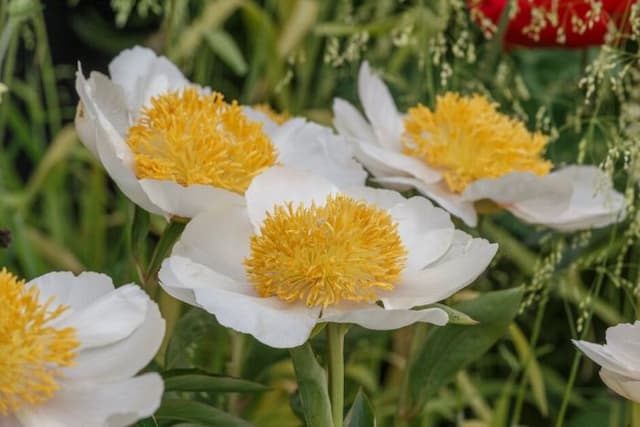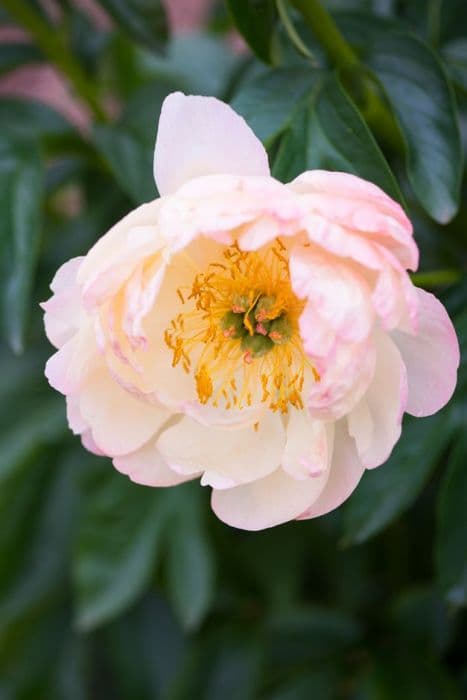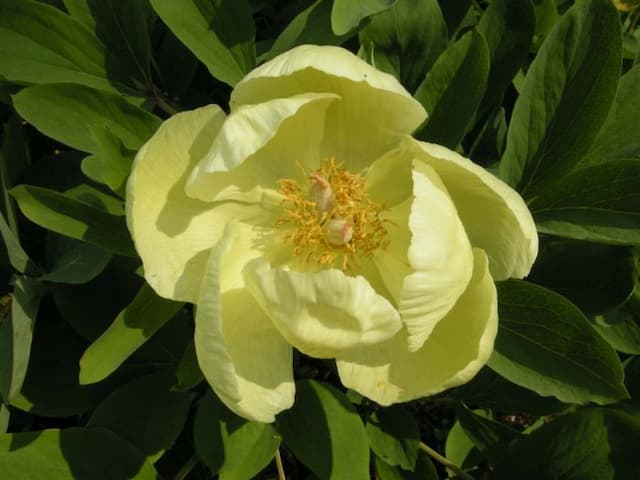Chinese Peony Paeonia lactiflora 'Primevère'

ABOUT
The plant known as 'Primevère' has a stunning floral display. It is characterized by large, showy blossoms with a unique two-tone coloration. The flowers are mostly white but with a subtle blush of pale yellow at the base of each petal, giving them a delicate, creamy appearance. This soft pastel hue is highlighted by the abundant, ruffled petals that form the full, rounded shape of each bloom. The flowers are nicely contrasted by deep green foliage, which is lush and contributes to the plant's overall beauty. The foliage is made up of broad, glossy leaves that provide an attractive backdrop for the ornate flowers. The plant has a bushy, robust form and produces a sumptuous floral display that makes it a captivating addition to any garden space where color and elegance are desired.
About this plant
 Names
NamesFamily
Paeoniaceae.
Synonyms
Chinese Peony, Common Garden Peony, Garden Peony.
Common names
Paeonia lactiflora 'Primevère'
 Toxicity
ToxicityTo humans
The common name for Paeonia lactiflora 'Primevère' is Peony. Peonies are considered to be of low toxicity to humans. They are not generally known to cause severe poisoning when ingested. However, sensitive individuals might experience mild gastrointestinal upset if they consume parts of the plant.
To pets
The Peony is considered to be mildly toxic to cats and dogs. If a pet ingests part of the plant, it may exhibit symptoms such as vomiting, diarrhea, and drooling. While serious complications are rare, it's advisable to keep an eye on your pet and contact a veterinarian if symptoms persist or worsen.
 Characteristics
CharacteristicsLife cycle
Perennials
Foliage type
Deciduous
Color of leaves
Green
Flower color
White
Height
2-3 feet (0.6-0.9 meters)
Spread
2-3 feet (0.6-0.9 meters)
Plant type
Herb
Hardiness zones
3
Native area
Asia
Benefits
 General Benefits
General Benefits- Aesthetic Appeal: Paeonia lactiflora 'Primevère', commonly known as Chinese peony 'Primevère', has large double flowers with a creamy white outer petal and a lemon-yellow center, providing a striking visual display.
- Seasonal Interest: It blooms in late spring to early summer, offering a burst of color after the early spring flowers have faded.
- Attracts Pollinators: The blossoms attract butterflies and bees, supporting local ecosystems.
- Cut Flower Use: The blooms are long-lasting when cut and make excellent arrangements for indoor decoration.
- Garden Design: The plant can be used in mixed borders, flower beds, and as a focal point in gardens due to its form and height.
- Hardiness: It is a hardy perennial suited to many climates and can survive cold winters once established.
- Low Maintenance: Once established, peonies require minimal care other than occasional watering and fertilization, making them a choice plant for low-maintenance gardening.
- Deer Resistant: The plant is not a preferred food source for deer, reducing the likelihood of damage in gardens frequented by wildlife.
- Perennial Growth: As a perennial, the plant will return year after year without the need for replanting.
 Medical Properties
Medical PropertiesThis plant is not used for medical purposes.
 Air-purifying Qualities
Air-purifying QualitiesThis plant is not specifically known for air purifying qualities.
 Other Uses
Other Uses- Floral Arrangements: Peony 'Primevère' is often used in large, lush floral arrangements due to its attractive double bloom form.
- Culinary Decorations: The petals of Peony 'Primevère' can be crystallized and used as elegant decorations for desserts and cakes.
- Garden Design: Peony 'Primevère' is used as a specimen plant in garden designs to create focal points due to its size and color.
- Fragrance Production: The delicate fragrance of Peony 'Primevère' can be used in the production of perfumes and scented oils.
- Wedding Decor: Peony 'Primevère' can be incorporated into bridal bouquets and wedding decor for a romantic touch.
- Photography: The striking appearance of Peony 'Primevère' makes it a popular choice for botanical photography and art.
- Color Dye: Petals of Peony 'Primevère' can be used to create a natural dye for fabrics or art projects.
- Educational Use: Peony 'Primevère' can serve as an educational tool for botany students studying the morphology of flowers.
- Literary Inspiration: The striking beauty of Peony 'Primevère' makes it a common botanical reference in poetry and literature.
- Companion Planting: Peony 'Primevère' can be planted alongside other perennials to create complementary color schemes in the garden.
Interesting Facts
 Feng Shui
Feng ShuiThe Peony is not used in Feng Shui practice.
 Zodiac Sign Compitability
Zodiac Sign CompitabilityThe Peony is not used in astrology practice.
 Plant Symbolism
Plant Symbolism- Prosperity: Peonies typically symbolize prosperity due to their lush, full blooms and association with spring, which is often a sign of rejuvenation and abundance.
- Romance: The peony, with its large, often soft-colored flowers, is widely regarded as a symbol of romance and love, making it a popular choice for weddings and romantic gestures.
- Bashfulness: In Victorian times, flowers were used to convey a secret language of emotions, and peonies were associated with bashfulness or a sense of modesty.
- Compassion: Some cultures associate peonies with compassion, possibly because of the nurturing way the plant grows and cares for its flowers.
- Good Fortune: Peonies are believed to bring good luck and positivity, which is why they're often used in celebrations, particularly in Asia.
- Honor: They also represent honor and high esteem, indicating respect for the recipient when given as a gift.
- Happy Marriage: Due to their romantic associations, peonies are often connected with the idea of a happy and blissful marriage.
 Water
WaterThe Common Peony (Paeonia lactiflora 'Primevère') should be watered deeply, allowing the soil to be thoroughly moistened to a depth of about one to two inches. It is important to avoid overwatering, so allow the top inch of soil to dry out between waterings. Typically, watering once a week with about one gallon of water per plant is sufficient, but this may need to be adjusted during particularly hot or dry weather conditions when additional water may be necessary.
 Light
LightThe Common Peony thrives in full sun to partial shade. An ideal spot offers at least six hours of sunlight a day, although too much high-intensity midday sun can sometimes stress the plant, especially in hotter climates. Dappled sunlight or morning sun with afternoon shade is often perfect for balancing light exposure.
 Temperature
TemperatureThe Common Peony prefers temperate climates and can survive in temperatures as low as -20°F and as high as 90°F. However, the ideal growing temperature range for this plant is between 65°F and 75°F. It is important to protect the plant from extreme temperature fluctuations that might occur outside of this range.
 Pruning
PruningPruning the Common Peony is important for removing spent blooms and dead foliage, promoting healthy growth and preventing disease. The best time to prune is after flowering in the summer, when all the petals have fallen. Cut back the flower stems to the first set of true leaves. In the fall, it's advisable to cut back the entire plant to about three inches above the ground to prepare for winter.
 Cleaning
CleaningAs needed
 Soil
SoilFor Chinese Peony 'Primevère,' a well-draining, loamy soil that is rich in organic matter is ideal. Incorporate compost or peat moss into the soil to improve its structure. The soil pH should be neutral to slightly alkaline, around 6.5 to 7.5. Ensuring proper drainage is crucial to prevent root rot, which the plant is prone to in poorly draining soils.
 Repotting
RepottingChinese Peony 'Primevère' typically does not need frequent repotting and prefers to be left undisturbed. It should be repotted only every 3 to 4 years or when it has outgrown its current container. However, it's often grown in ground where it can remain without repotting for many years if the soil conditions are ideal.
 Humidity & Misting
Humidity & MistingChinese Peony 'Primevère' fares well in average garden humidity levels and does not require any special humidity considerations. These plants are well adapted to outdoor conditions and do not typically need additional humidity control when planted in the ground.
 Suitable locations
Suitable locationsIndoor
Not ideal for indoors; needs sun, seasonal cold.
Outdoor
Plant in full sun; well-drained soil; space 2-3 feet.
Hardiness zone
3-8 USDA
 Life cycle
Life cyclePaeonia lactiflora 'Primevère', commonly known as Chinese peony or common garden peony, begins its life cycle as a dormant tuberous root system. In the spring, it breaks dormancy to produce stems and deeply lobed leaves. Buds develop into large, fragrant blossoms in late spring to early summer, usually white with a yellow center. After flowering, the plant sets seed in the form of a dry capsule, which matures by late summer and, if not deadheaded, can contribute to self-seeding. Throughout the summer, the foliage provides a backdrop for other plants before it starts to yellow and die back as the plant enters dormancy in the fall. In winter, the peony remains dormant underground until the cycle restarts the following spring.
 Propogation
PropogationPropogation time
Late summer to autumn
The most popular method of propagation for the Peony 'Primevère' is division, which is ideally carried out in the fall, after the plant has died back and is dormant. To propagate by division, you should carefully dig up the peony clumps and gently shake or wash off the soil to reveal the structure of the tuberous roots. Using a sharp knife, you can divide the root clump making sure each section has at least 3-5 eyes, which are the potential growth points for next year's stems. The divisions should then be replanted promptly, positioning the eyes about 1-2 inches (2.5 cm - 5 cm) below the soil surface and spaced around 3 feet (about 91 cm) apart to allow room for growth. Water the newly planted divisions thoroughly to settle the soil and help them establish before the onset of winter.
